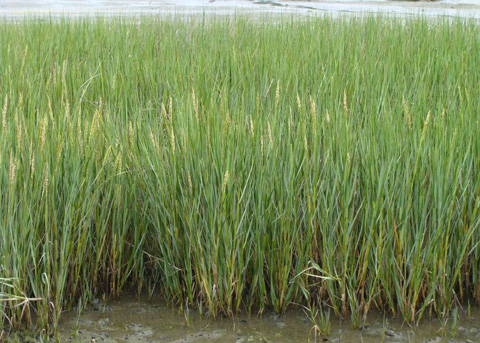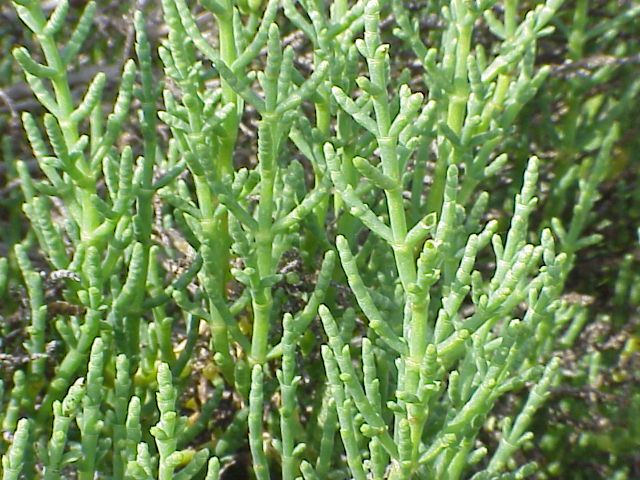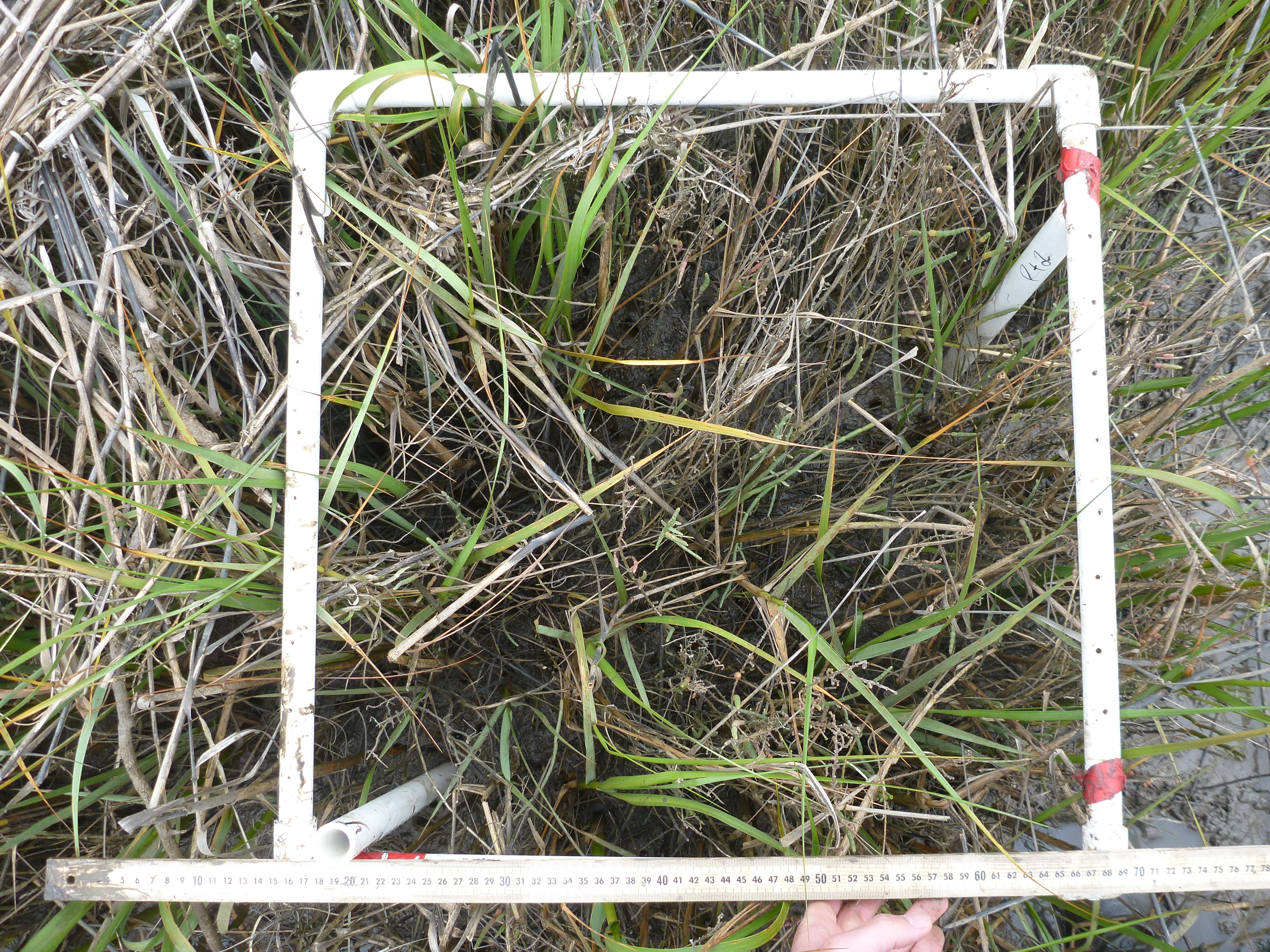Changes in climate can dramatically alter the look and function of natural ecosystems. For example, predicted increases in storm frequency and intensity along with long-term sea level rise may profoundly impact salt marshes where soil salinity and water level critically determine the distribution and abundance of dominant plants. Such changes could threaten the important services these natural areas provide to coastal communities. As a result, understanding climate influences on salt marshes is a focus of conservation and restoration projects, particularly in southern California where we have lost the majority of these important habitats.
Climate change may modify the composition and functioning of salt marshes by influencing how species interact. For example, salt marsh plants can negatively or positively affect neighboring plants. Neighbors may reduce the growth and survival of some plants because they compete for shared resources like nutrients and sunlight. In contrast, neighbors may facilitate the success of other plants by ameliorating stressful environmental conditions (e.g., high temperature and soil salinity), thereby enhancing plant performance. An important ecological theory, the Stress Gradient Hypothesis, predicts that as environmental stress increases, species interactions will shift from competition (co-occurring species negatively impact each other) to facilitation (when the presence of one species benefits another species). Because changes in climate can influence the amount of stress plants experience, climate change may alter habitats by affecting how species interact.
Unfortunately, studying climate change effects on natural ecosystems is challenging given the difficulty of creating realistic climates in the lab and the expense of conducting long-term experiments in the field that capture major climatic events. One solution to this problem is to conduct comparative field studies that specifically target periods during strong El Niño events when rainfall and sea level are typically greater than normal. The 2015-2016 El Niño provided such an opportunity to examine climate impacts in salt marshes, such as decreased salinity from increased storm activity and increased water level and salt water intrusion from sea level rise.

Spartina foliosa is a species of grass known by the common name cordgrass.

Pickleweed,
Salicornia virginica, is a common salt marsh species.
We conducted manipulative field experiments at two salt marshes in San Diego during 2016 (San Dieguito Lagoon and Kendall Frost Marsh). We grew two dominant marsh plants, cordgrass and pickleweed, with and without neighboring plants. To do this, we identified marsh plots with both plants growing together, assigned plots to one of the two focal plant species, and then either removed or left neighboring plants within these plots.
After four months, neighbors reduced cordgrass biomass by 22% at San Dieguito Lagoon. This effect was largely the result of neighbors reducing the density of cordgrass stems. Currently, we are exploring the mechanisms by which neighbors suppressed cordgrass biomass and stem density. Because cordgrass neighbors did not alter soil salinity or nutrient levels, we have rejected these as causative agents. However, the much fuller plant canopy of neighboring plants at San Dieguito may have negatively impacted cordgrass via light competition.
To our surprise, neighbors did not affect cordgrass biomass at our other site, Kendall Frost Marsh. The reason for the different effect of neighbors on cordgrass between these sites is uncertain. However, cordgrass stems at San Dieguito Lagoon (both cordgrass and pickleweed) were twice as big as plants at Kendall Frost Marsh. This could be evidence that cordgrass was more stressed at Kendall Frost Marsh. If true, our site-specific effect of neighbors on cordgrass (negative at San Dieguito, neutral at Kendall Frost) matched the predictions of the Stress Gradient Hypothesis. Namely, the interaction between neighbors and cordgrass became more positive at the more stressful site.
Over the course of sampling in 2016, we didn’t see an effect of neighbors on pickleweed at either site. Pickleweed is a much more slowly growing plant than cordgrass, so a longer time frame may be required to detect any neighbor effects.

We studied how cordgrass and pickleweed plants interacted with their neighbors in plots like this.
We hired a pilot to conduct aerial surveys of these marshes and several others to examine landscape-level changes in marsh vegetation during 2016. Such surveys provide important information related to the functioning of salt marshes, such as marsh coverage, plant species composition, and marsh elevation. These surveys used a FAMIS-CIR system to capture visible and near infrared digital images of the salt marsh plant community. These images are being used to generate a digital surface model of the marsh that will provide information about elevation and canopy height. Additionally, we observed a significant outbreak of scale insects on cordgrass in South San Diego Bay. Previous research in Dr. Long's lab found that under some environmental conditions, these insects can dramatically reduce cordgrass growth and longevity. We are currently using the aerial surveys to determine how we can quantify the extent and impact of this outbreak across an entire salt marsh.
Together, our field experiments and aerial surveys are providing important information on how dominant salt marsh plants interact with each other to shape important salt marsh ecosystems. Because of our unexpected results, we are currently planning to repeat the field experiments in 2017 to determine if and how plant interactions change between study years. One reason we may expect different results in 2017 is that we’ve had significantly more rainfall this year than at the same point in time in 2016.
Dr. Jeremy Long and
Dr. David Lipson are Associate Professors in the Department of Biology at San Diego State University.
Dr. Doug Stow is a Professor in the Department of Geography at San Diego State University. COAST provided funding for this project: Rapid Response Funding Program Award# COAST-RR-2015-006, December 2015.